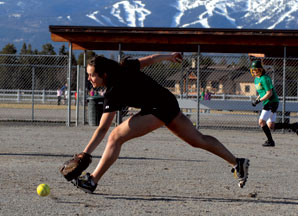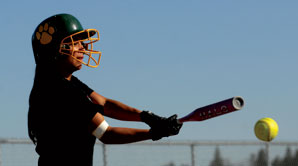WHITEFISH – In softball, a team puts nine players in the field for defense. The Lady Bulldogs have exactly nine players who have ever played organized softball before. An injury or absence ensures that a freshman with no prior softball experience will be in the starting lineup.
And with only 12 players – including six freshmen – on the roster this year, the Bulldogs don’t even have enough players for a junior varsity team. If you signed up, you’re playing varsity.
“It’s very intense,” said freshman Jayde Eason, whose prior softball experience was a brief stint in second grade. “It’s challenging because I have to keep up with them everyday and get better everyday.”
So one can imagine the team’s collective jubilance on April 10, when the Bulldogs beat rival Columbia Falls 6-3 for the first time in more than four years. Hailey Mortensen, a catcher and one of the team’s three seniors, has played varsity for four years and never beaten Columbia Falls.
 |
|
Whitefish High School senior Kaitlyn Wehrli, front, lunges to stop the ball during a softball practice in Whitefish. |
“It felt so awesome,” Mortensen said.
Junior shortstop Madison Tveidt said the Columbia Falls victory spoke volumes for this inexperienced but resilient squad. Tveidt, Mortensen and other upperclassmen have been working patiently with the younger girls, who, by all accounts, are progressing rapidly.
“That game says a lot about this team already,” Tveidt said.
On paper, this team looks like an unlikely candidate to end the long drought against Columbia Falls, but it’s clear these girls could not care less about what things look like on paper. They might not look like candidates to qualify for the state tournament either, but that’s exactly their plan. And coach Alan Compton doesn’t doubt they can do it.
Compton has instilled a realistic workman’s philosophy into his players, simplifying the game and breaking it down into straightforward goals that can be achieved through focus, effort and teamwork, or “trust.” The goals don’t require 15-run outbursts or magical no-hitters.
Compton tells his girls: Aim for seven runs per game, cut down on mental errors while acknowledging that mistakes aren’t the end of the world, and play within themselves. It’s Underdog 101 and it’s working.
The Bulldogs are 3-2 on the season, with victories over Columbia Falls and Class AA Flathead. Larry Smith, head coach of Polson, a perennial Class A softball powerhouse, believes the Bulldogs have the ability and tenacity to make it to state. Smith called the Bulldogs his team’s biggest threat in the Northwestern A conference.
And Compton brings up one other key ingredient, one that is vital for any team, let alone a dozen teenage girls.
“We don’t have any drama, which can kill a team,” Compton said. “We have really good chemistry, which makes it really nice for me.”
 |
|
Emma Baldonado makes contact with the ball during a Whitefish High School softball practice in Whitefish. |
Other Class A softball programs are struggling with low turnouts as well, Compton said. Neither Browning nor Stevensville, like Whitefish, has enough players for a junior varsity team, he said.
Sports are cyclical, fluctuating in popularity and influenced by the characteristics of individual classes, which can impact the turnout for a certain sport. But Compton also said softball has challenges specific to its sport.
Softball has a hard time competing with the other two Class A spring sports, tennis and track. Much of it is social: tennis and track offer mingling with boys, Compton said. In addition, whereas track attracts athletes just looking for a way to stay in shape for other sports or who are simply curious, softball tends to only attract girls who are specifically compelled to the sport.
Furthermore, Whitefish has its own challenges. Whitefish’s softball program is the only sport at the school not funded by the district, which is different than at other Class A schools as well, Compton said. The Bulldogs raise their own money, through fundraisers and donations. Each year, they raise about $22,000-$25,000, Compton said.
This season, a player’s parent who is a fishing guide has donated a fishing trip. The team is raffling off the trip and has received a good response so far. But Compton concedes that the stress of coming up with their own funds “wears on the players; it wears on all of us.”
Tveidt said not knowing if there will be enough money is tough on the girls.
“It’s hard to have a parent-student meeting and say we have to have this amount of money or we can’t play,” Tveidt said. “It puts pressure on the parents and they’re like, ‘Should we even have our kid play?’”
But the upside, Tveidt said, is that the uncertainty forces the girls to unite as a team, because if they don’t, they might not have a team. In a season like this one, that can make all the difference.
“It makes us come together,” Tveidt said, “and we know we have to come together.”